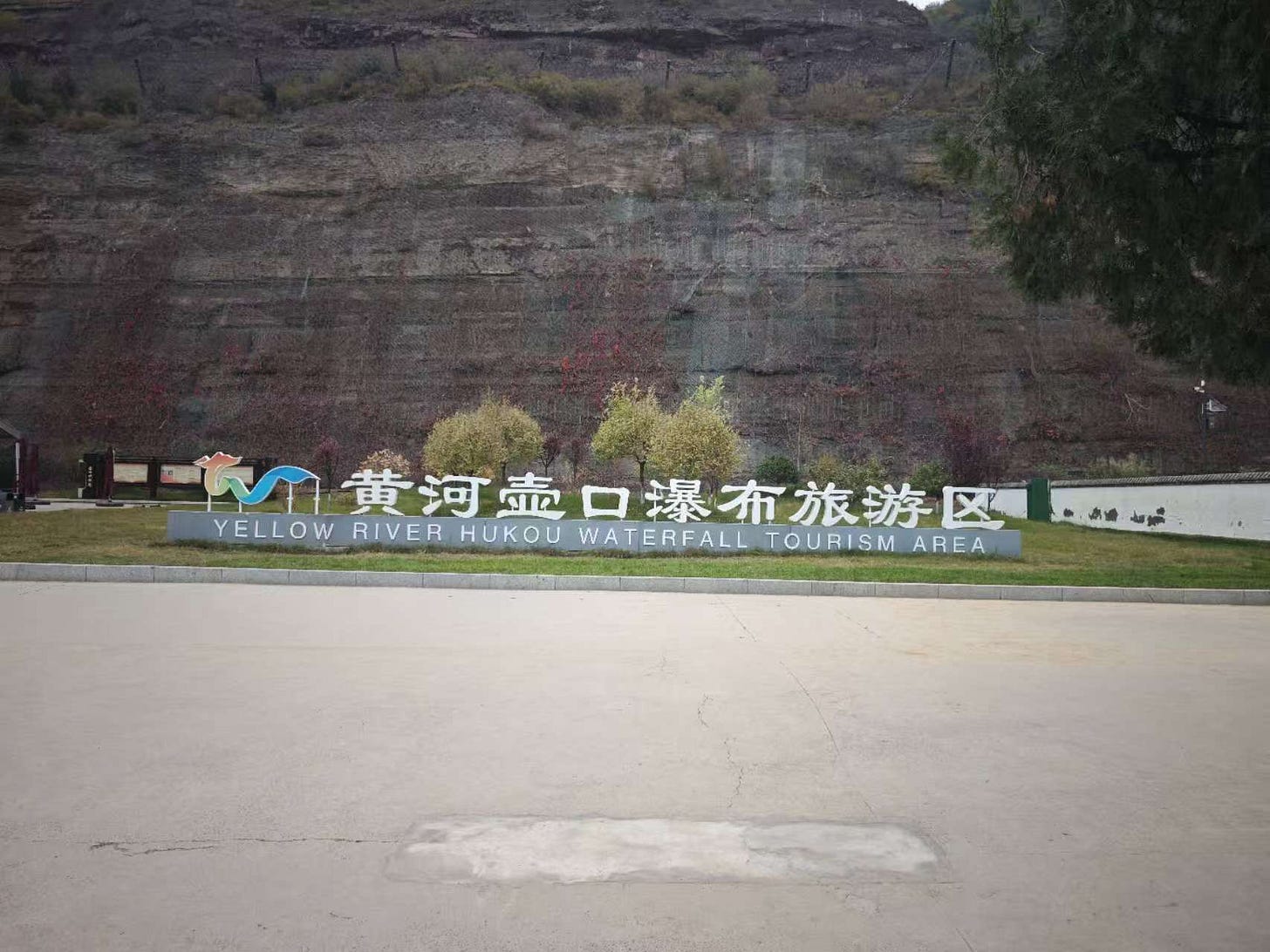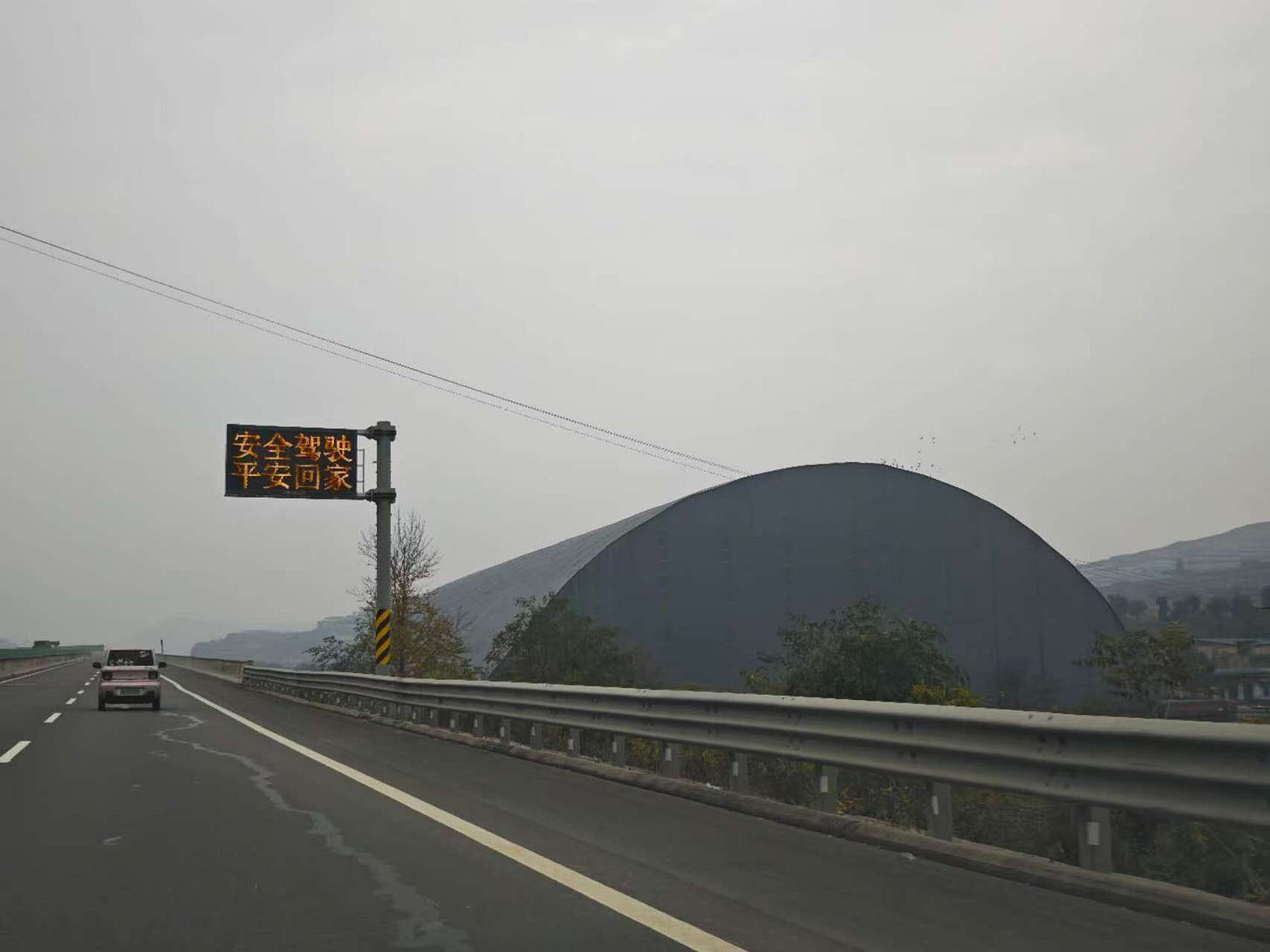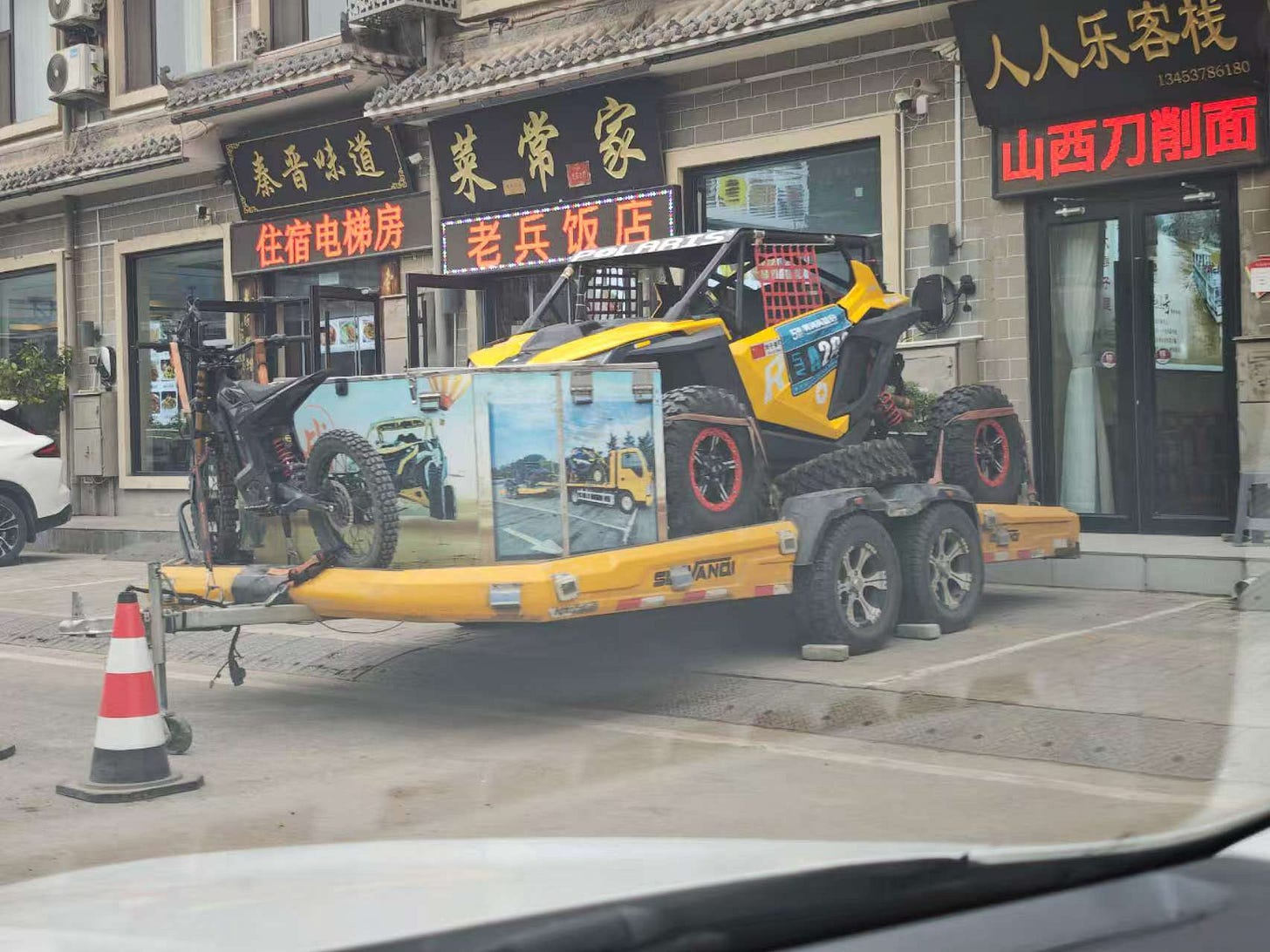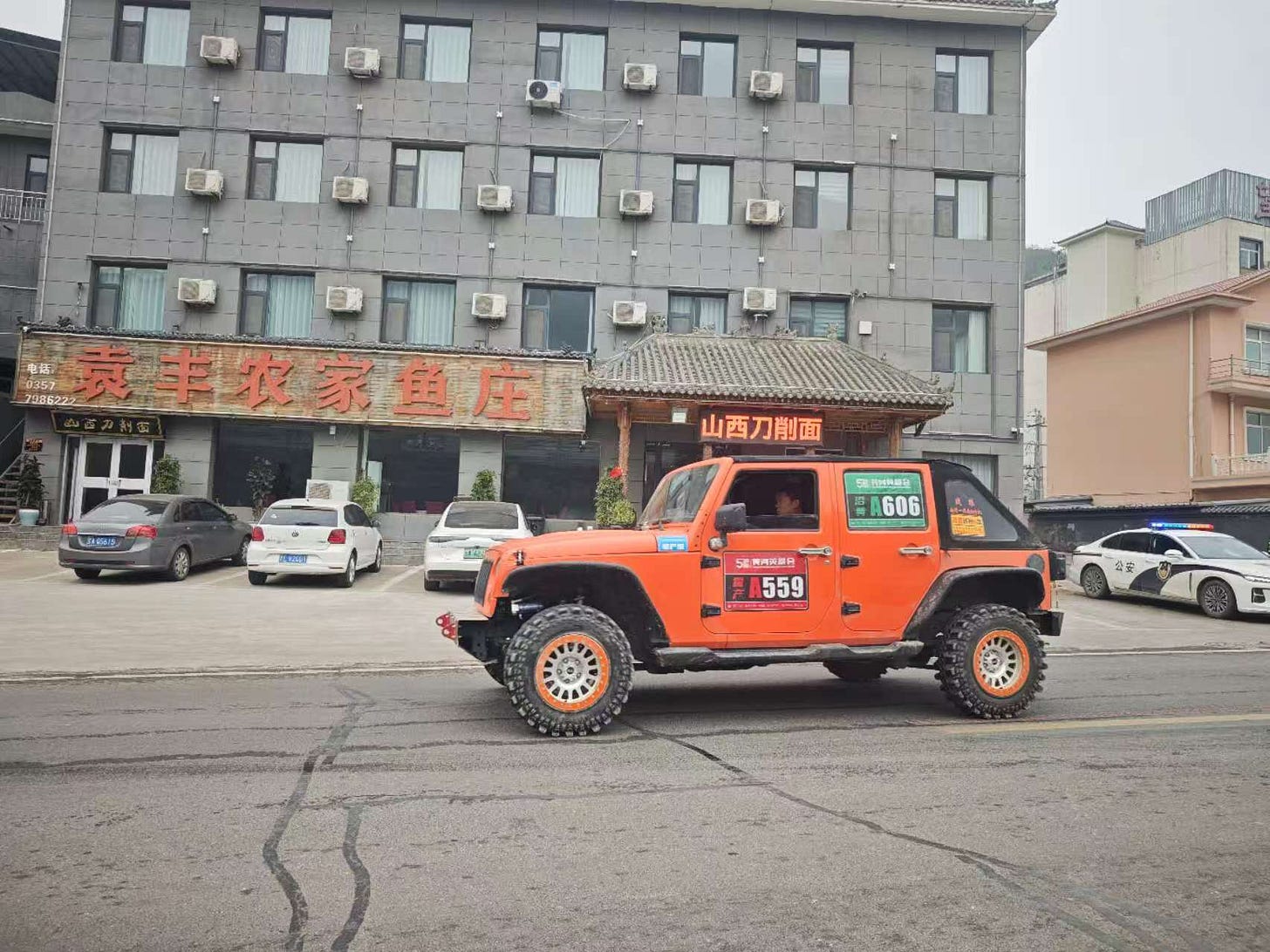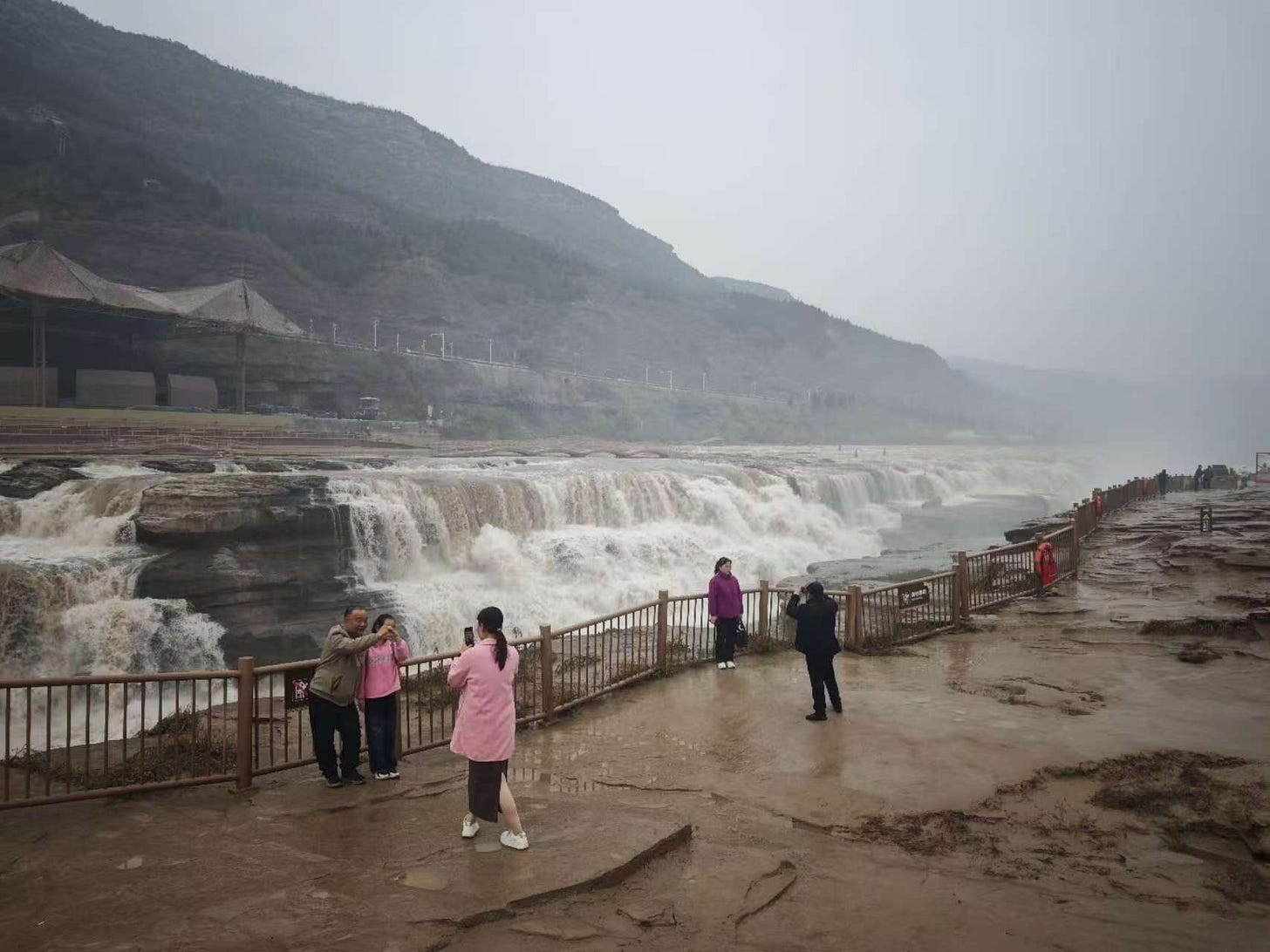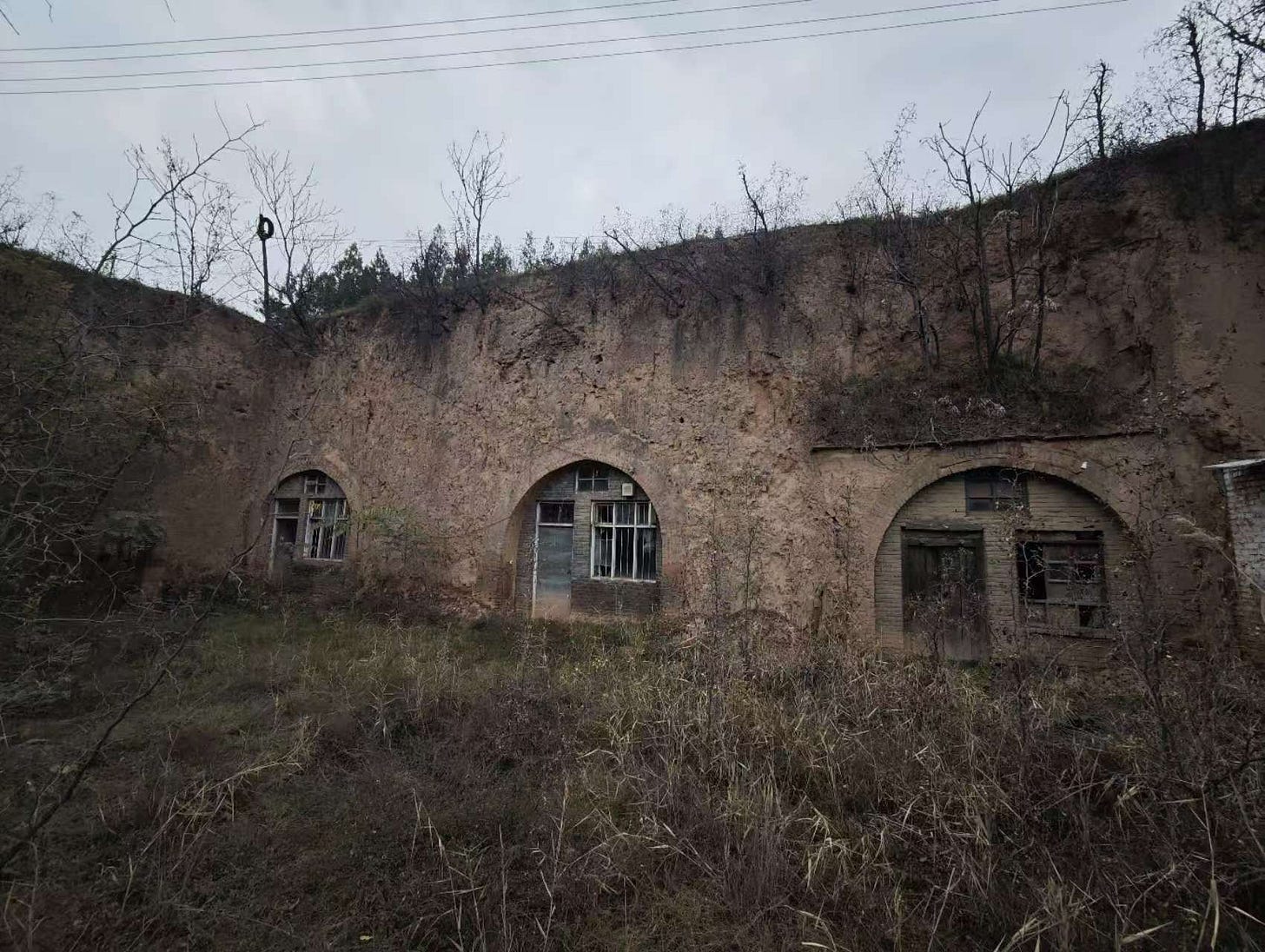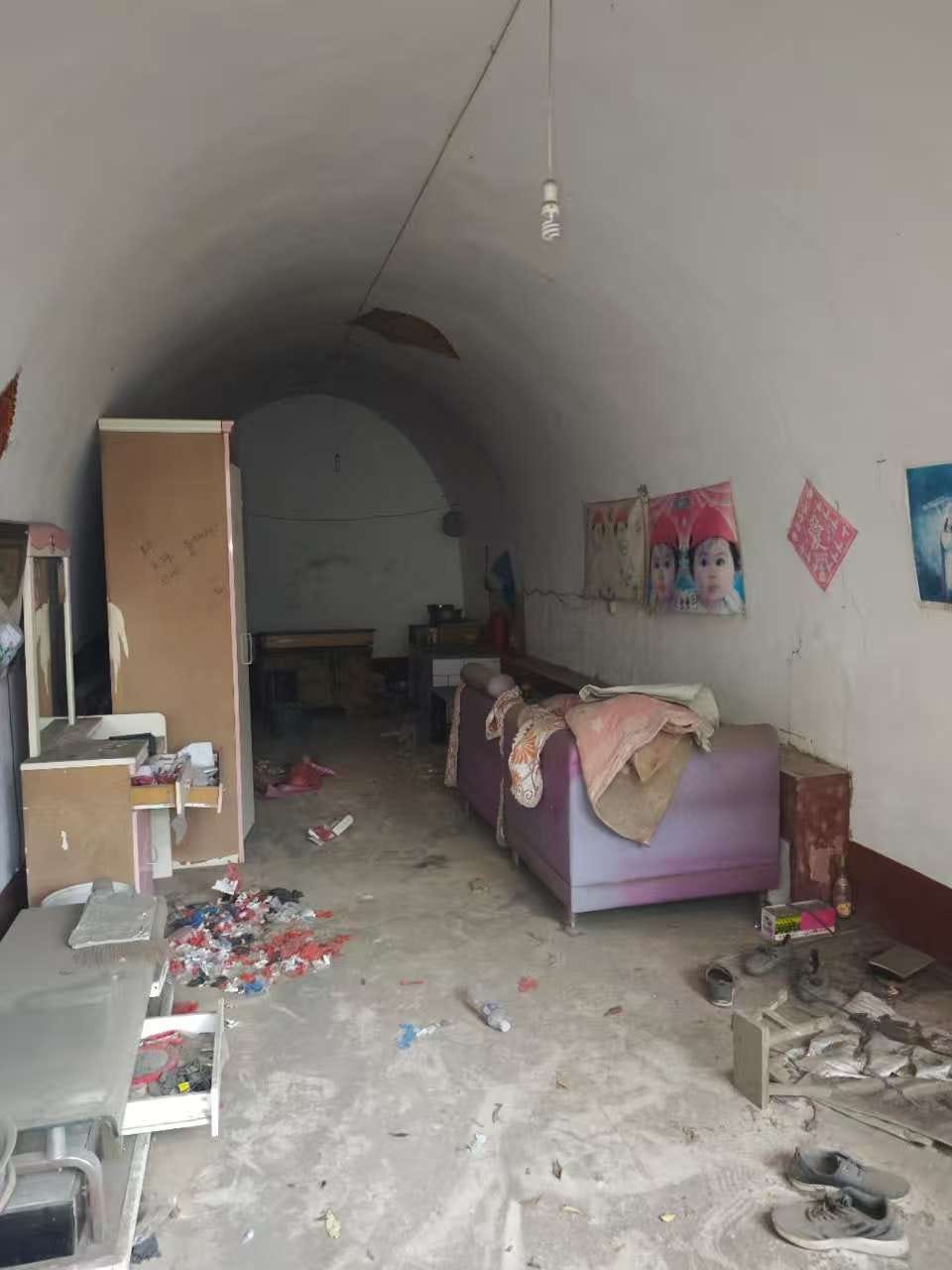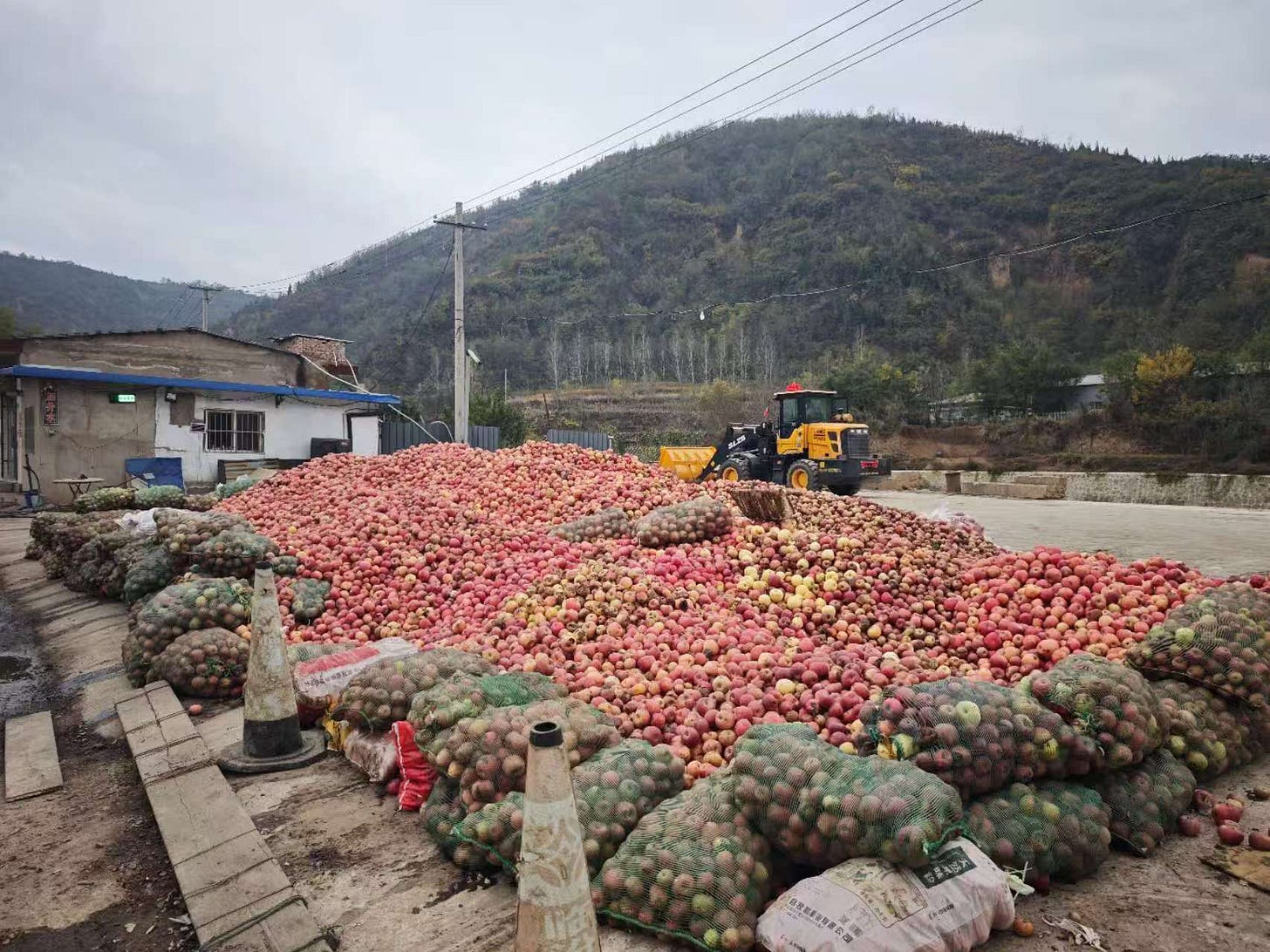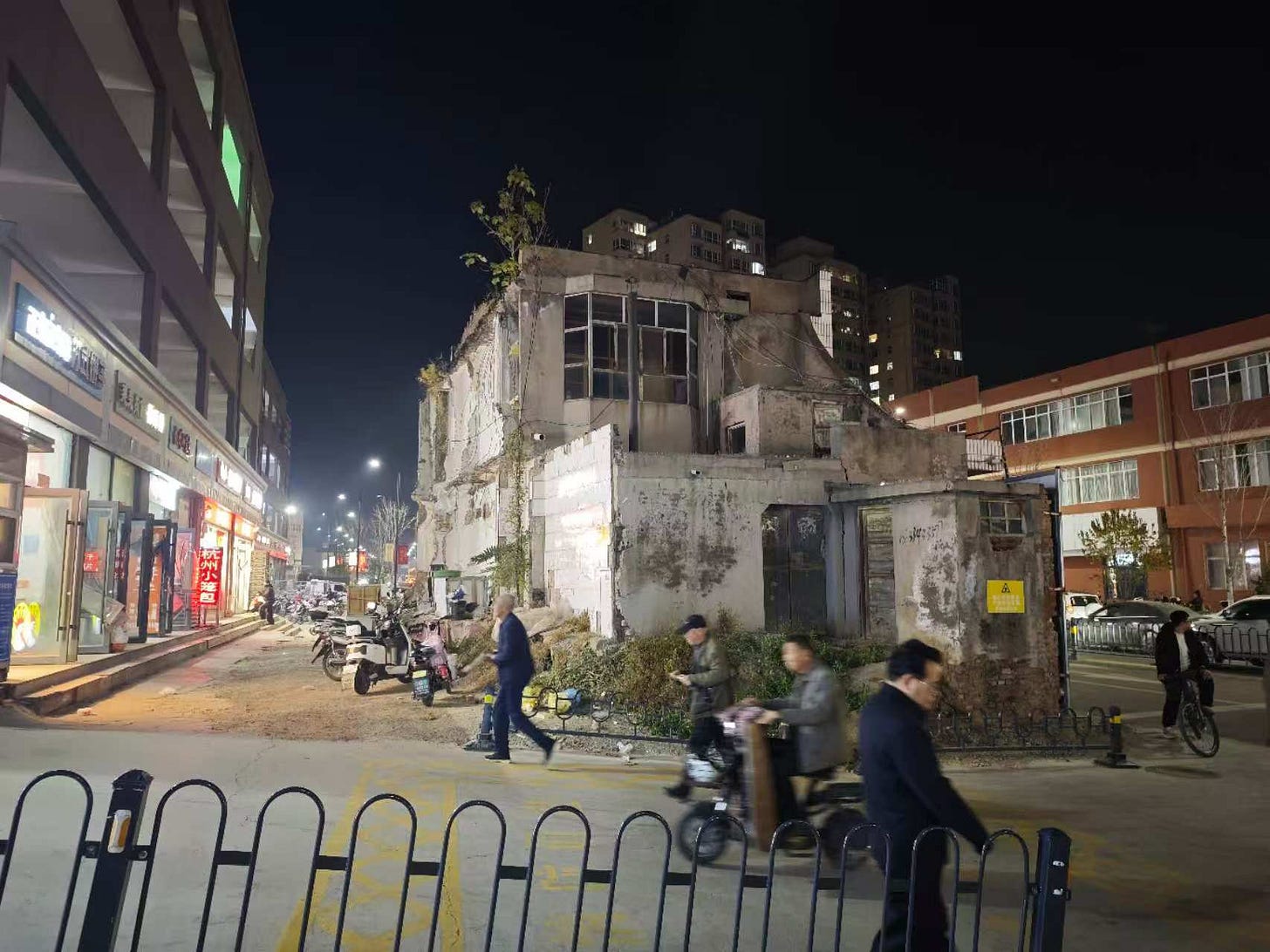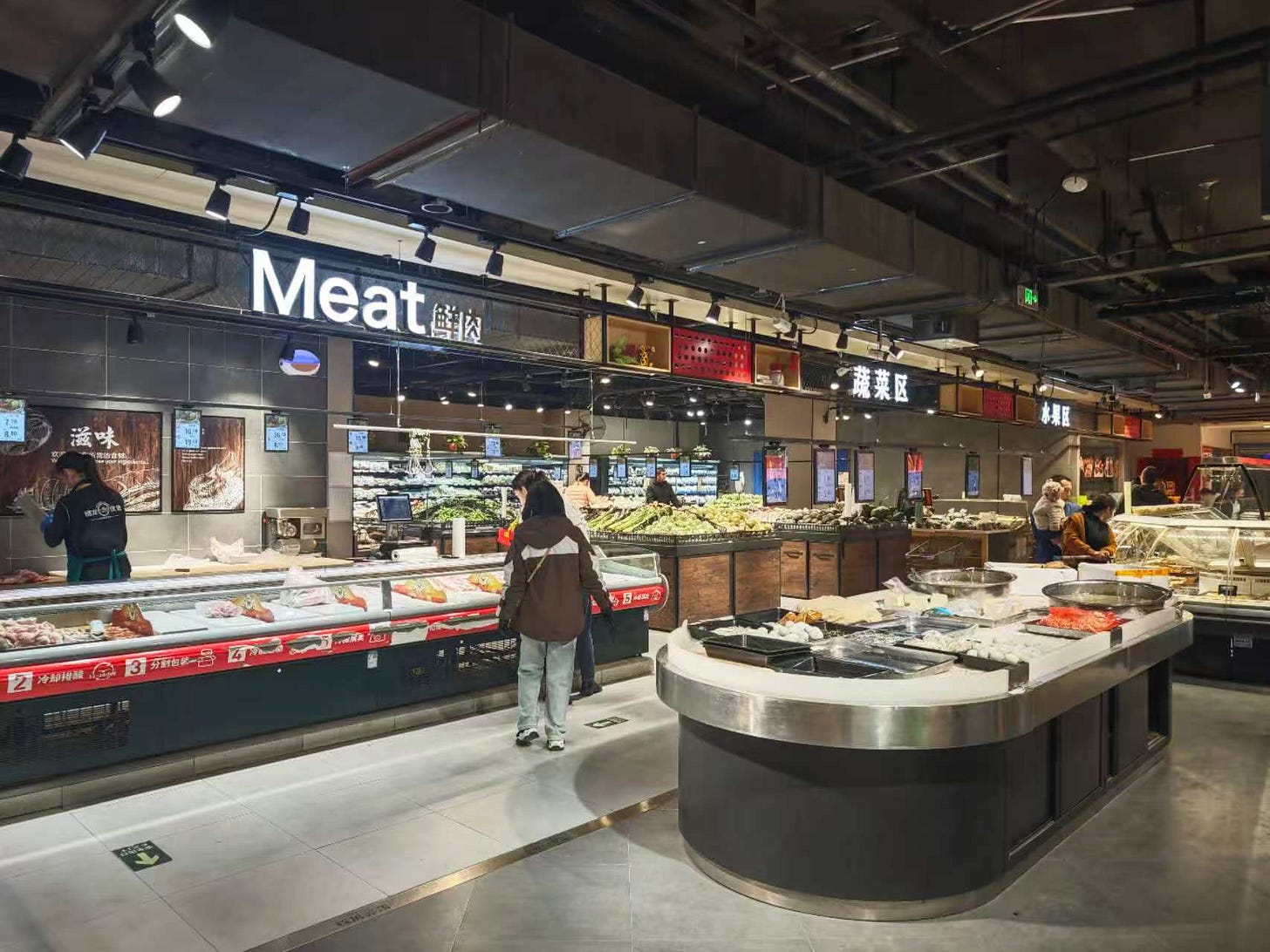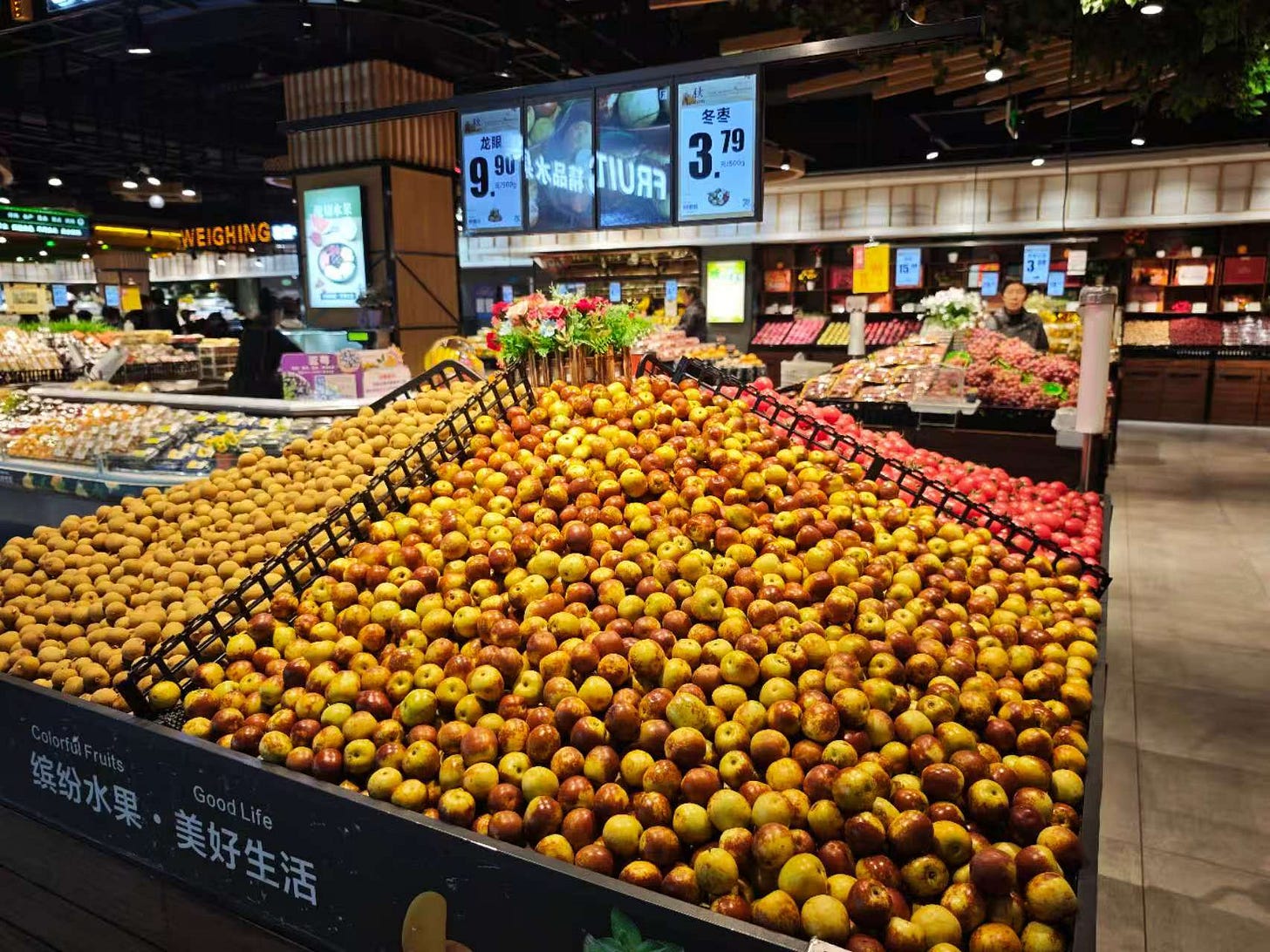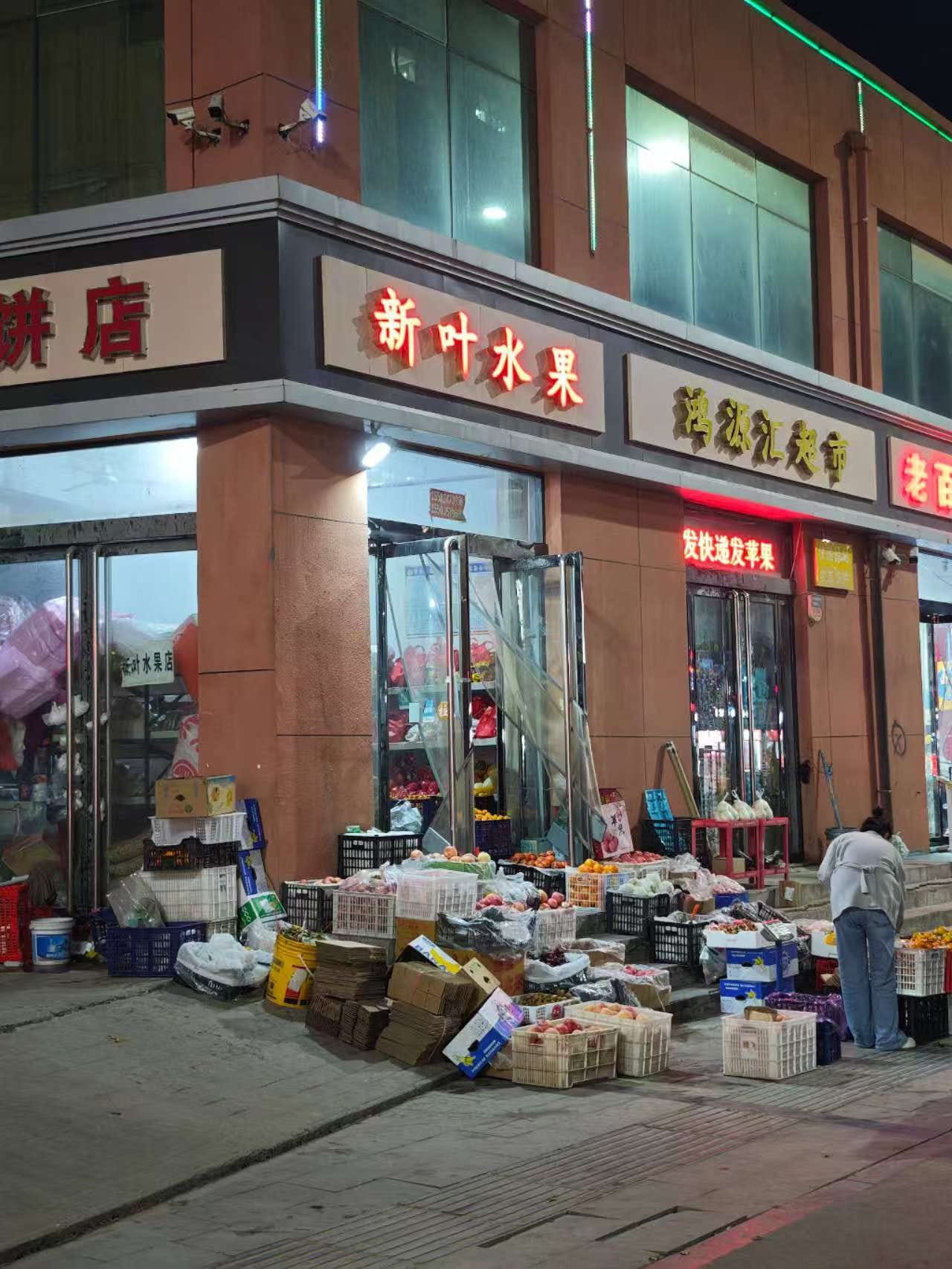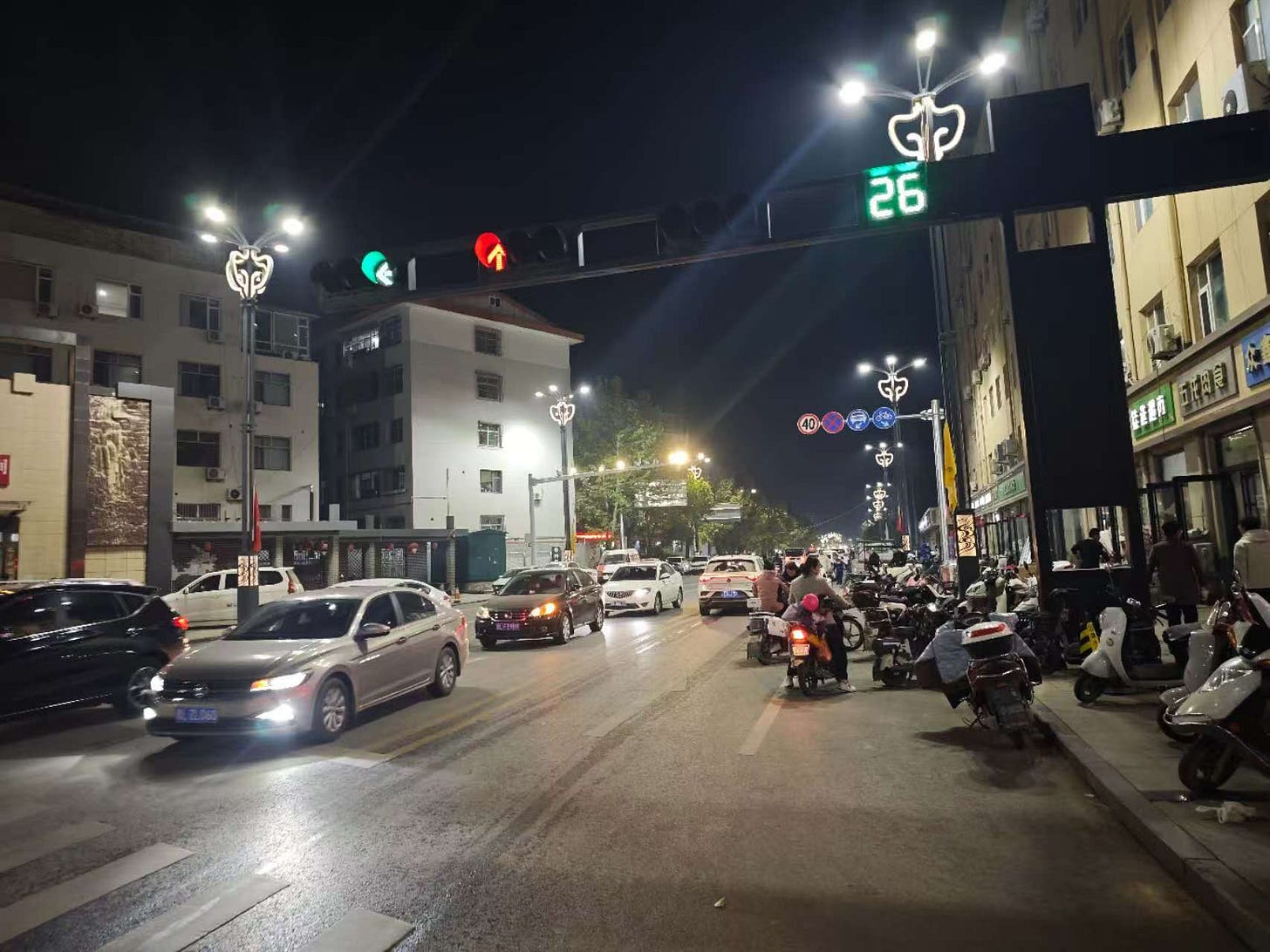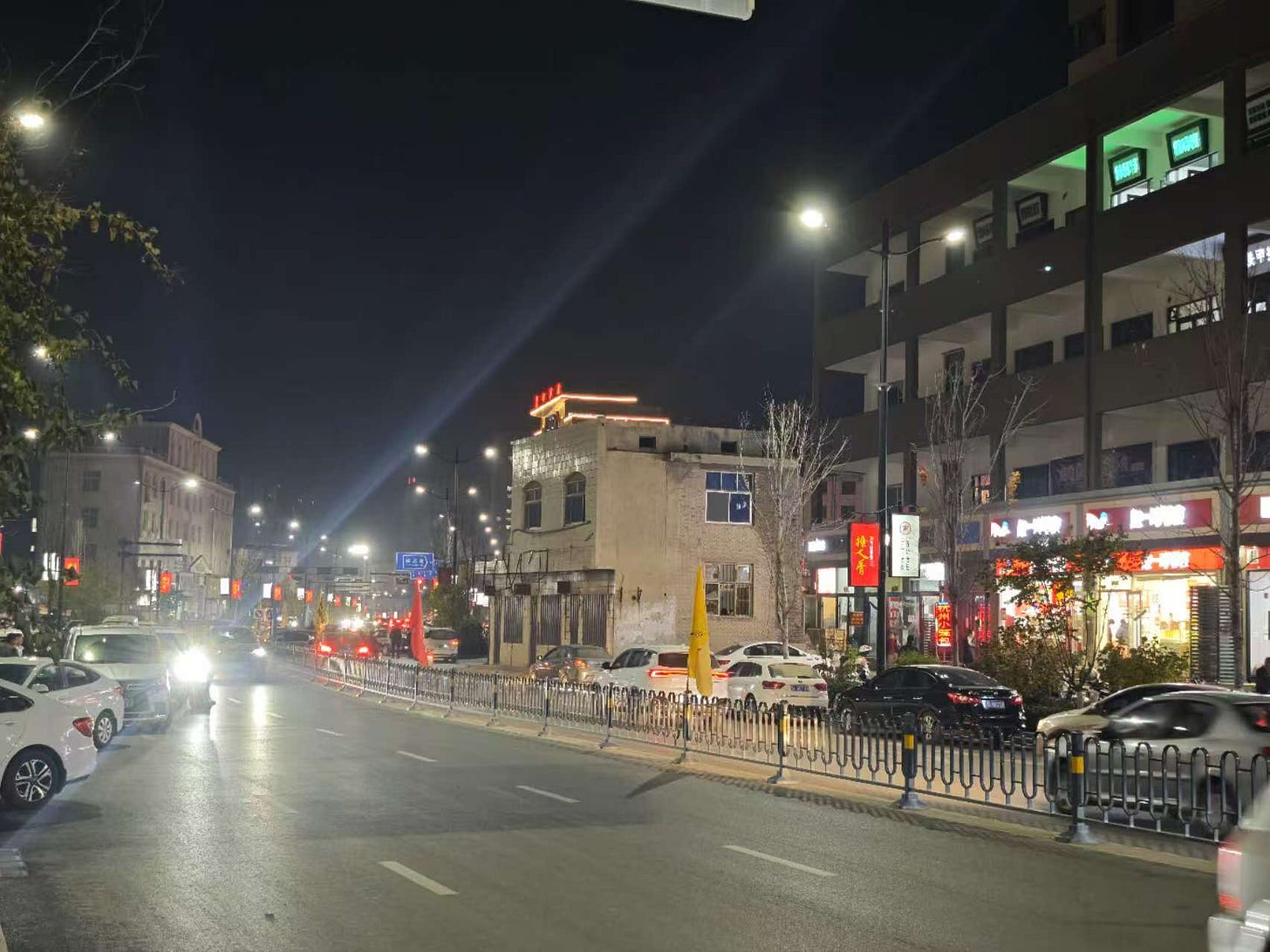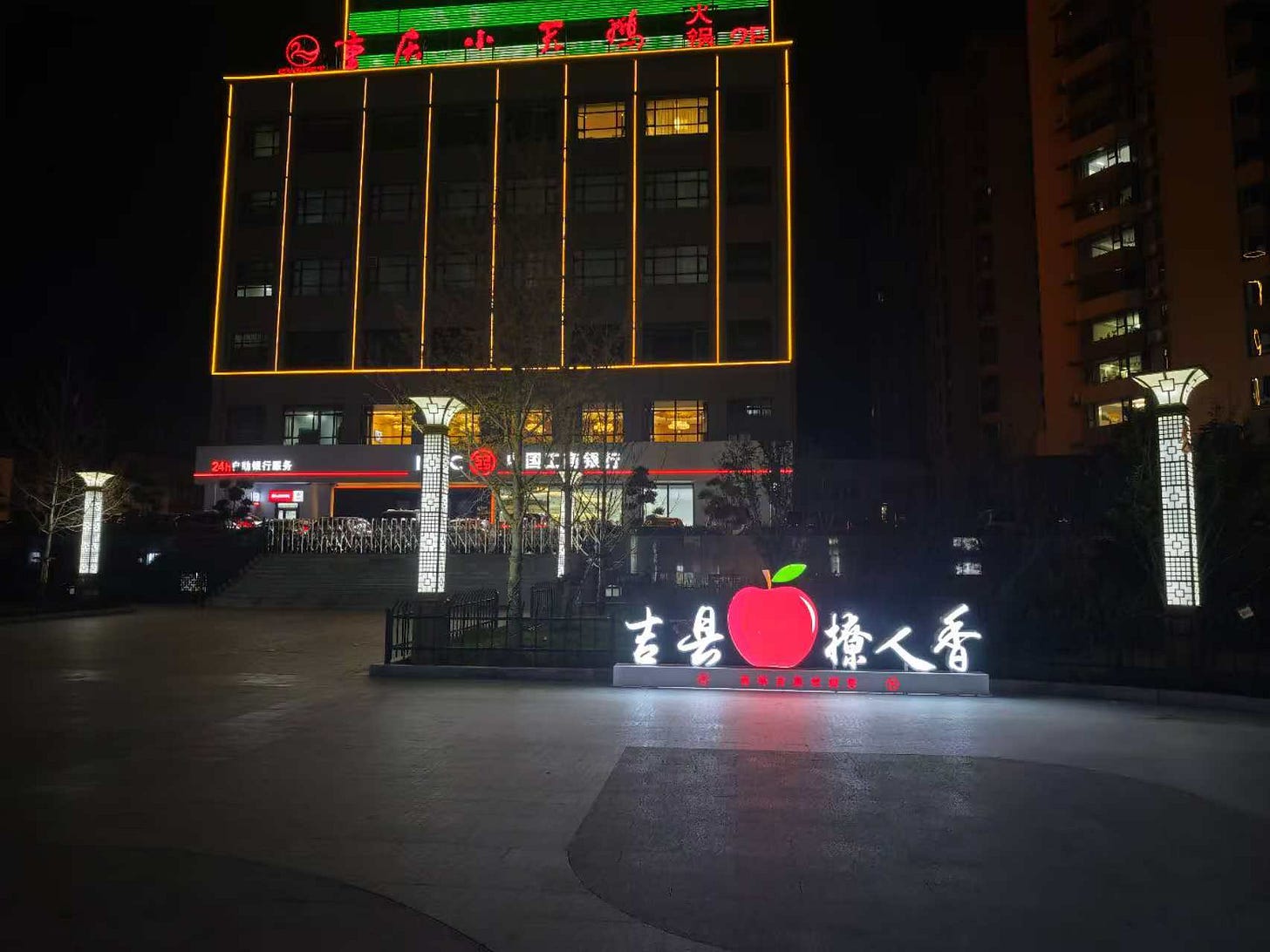Off the Beaten Track: Swapping Urban Uncertainty for Auspicious Apples in a Corner of Rural Shanxi
Linfen's rural Ji County has a lot going for it
This is the second article in my two-part series of my visit to Linfen City in Shanxi, which I proposed might be the most median city in China. Catch up on Part 1 here.
Exploring Rural Linfen
I began my second day in Linfen as auspiciously as possible with a late breakfast of a spicy local specialty: Linfen beef ball noodle soup. Then, I set off on a trip to rural Ji County in the far west of the city’s administrative area. In comparison with downtown Linfen, Ji County (吉县, lit. “auspicious county”) has a much stronger economic identity, with both a signature local product - apples - and a powerful tourism draw: the Yellow River Hukou Waterfall. Contrasting with the uncertainty I concluded for the development of Linfen City, Ji County’s future gave me more reason to be optimstic.
The waterfall is the only national 5A-rated tourist attraction in Linfen, which is a big deal. There are only 358 5A-rated tourist attractions in China. Think about them as you would see the National Parks in the USA - a powerful tourism draw often sufficient to economically sustain an entire region via dining, accomodations, and other consumption spending. While some large cities may have three or more, (Beijing has nine) most cities don’t have a single one. Hukou is the largest waterfall on the Yellow River and the second-largest in China.1 Here, the Yellow River forms the border between two provinces, so if you visit the waterfall from the Shanxi side, you’ll also see tourists in Yichuan County, Yan’an City, Shaanxi on the opposite bank.
For the 90-minute drive to the waterfall, and to conveniently explore Ji County at the same time, I decided to rent a car. Like most small cities in China, the cost of services in Linfen is generally calibrated to the lower local wages, which means they’re very affordable in my eyes, coming from Shanghai. My daily car rental from a national chain (Shenzhou) came out to just 108 CNY (15 USD) including fees and insurance.2
Immediately west leaving Linfen, the flat terrain continued for about 20 minutes of driving on the G22 expressway. The primary crop here is corn, but the harvest was already complete, so only rusty, withered stalks remained in the fields. Combined with the overcast skies, the atmosphere would have been quite gloomy, but for the bright pops of yellow from the ginkgo trees planted along the road and as windbreaks dividing the fields - a single spot of vibrancy in an otherwise somber landscape.
Suddenly, mountains appeared ahead of me, starkly jutting up over the broad plain. I entered a long tunnel, and when I exited, I was now in the mountains, following a small river along the gorge it had carved into the terrain. The fields disappeared, replaced by steep hillsides and rocky slopes. My GPS told me I’d entered Xiangning County, a coal-mining region of Linfen. The car’s temperature gauge showed the outside temperature had dropped by five degrees.
The terrain showed the evidence of decades of mining. Even from the expressway, I could see many muddy dirt trails disappearing into the hills, undoubtedly leading to mines. Deep channels formed by rainfall pouring down the hillsides made it look like the mountains - the earth itself - had been scratched to the bone by giant claws. There were few actual villages, other than mining camps and coal processing facilities, half of which lay abandoned and rusting…
Tourism Booms in Hukou Town
Emerging on the other side of the mountains in Ji County’s Hukou Town, the terrain dropped rapidly once again, descending into the Yellow River valley gorge. The sides of the road were stained black from coal falling off trucks, which I had seen before in Ordos, but the town was active and lively. I saw signs for the waterfall everywhere, but also posters advertising a major local event: the 6th Annual Linfen 520 Yellow River Heroes Challenge, an offroad rally racing event hosted in the town that had just kicked off. Hukou’s streets were clogged with modified off-road vehicles, both driving themselves and tugged on trailers.
As I drove through, it seemed like every restaurant was full of people, and surely every hotel room in the small town was booked too. Online, the event organizers claimed 500 racing teams from around the country were registered for the two-week event, competing for a total prize pool of 1.6 million CNY. Coming from a rural part of the world myself, I appreciate keenly the economic importance of these kinds of local festivals - and felt an unexpected pang of nostalgia and kinship, observing the sound monetization of good ol’-fashioned rural redneck fun in such an unexpected place.
At the Hukou Waterfall, the riverbed of the Yellow River suddenly drops 20 meters, which isn’t that much, but at the same time the river abruptly narrows from 300m wide down to just 50m, compressing an enormous volume of water into a relatively small area. The result is the waterfall, a booming wall of water, roaring and surging down the river bed, tossing spray and foam into the air. I visited in the middle of the week during the off-season, so most of the tourists here were elderly people on package tours, although I spotted a few families with younger children. I wondered why they weren’t in school…
“Dad, take a picture with me!” A young girl who looked about 10 years old pulled her dad into position for posing, while mom waited with the camera. “Like this, hold your fingers together in a heart.” Dad complied, but he was doing it wrong. “Nooo, like this! Finger and thumb!” Dad tried again, this time apparently sucessfully, and the picture was taken. “Okay, now we make a heart with our hands together. I make one half and you make the other half.” Dad tried, but he offered the wrong hand.
“Daa-aa-aad. You’re doing it wrong!” Dad laughed haplessly in confusion and mom had to get involved to position his hand in the correct position to form the other half of the heart. Finally this picture was taken too, and the girl squealed in delight at the (apparently acceptable) result.
After staying about 15 minutes, I made my way towards the exit. The waterfall was fine, but unless I wanted to take a picture with a donkey, there was not much else to do. A middle-aged lady approached, phone in outstretched hand, and I braced myself to obligingly take fake cheerful selfies with a stranger, but she surprised me. “Hi…” she said haltingly in Chinese. “I’m…also traveling by myself. Would you…take some pictures of me in front of the waterfall?” Pleased that she wasn’t asking for a selfie, and doubly pleased that she asked me in Chinese, instead of exaggeratedly miming the action and forcing a few words of broken English, I was more than happy to oblige.
The National Highway to Ji County
Leaving Hukou Town, I took the National Highway 309 towards the Ji County seat. The route followed the Yellow River gorge, and the views were great, but I needed to concentrate on the road, which was clogged with heavy trucks carrying coal, straining up the hills, which made overtaking on the winding two-lane road a dubious prospect, except for the brave - or the foolhardy.
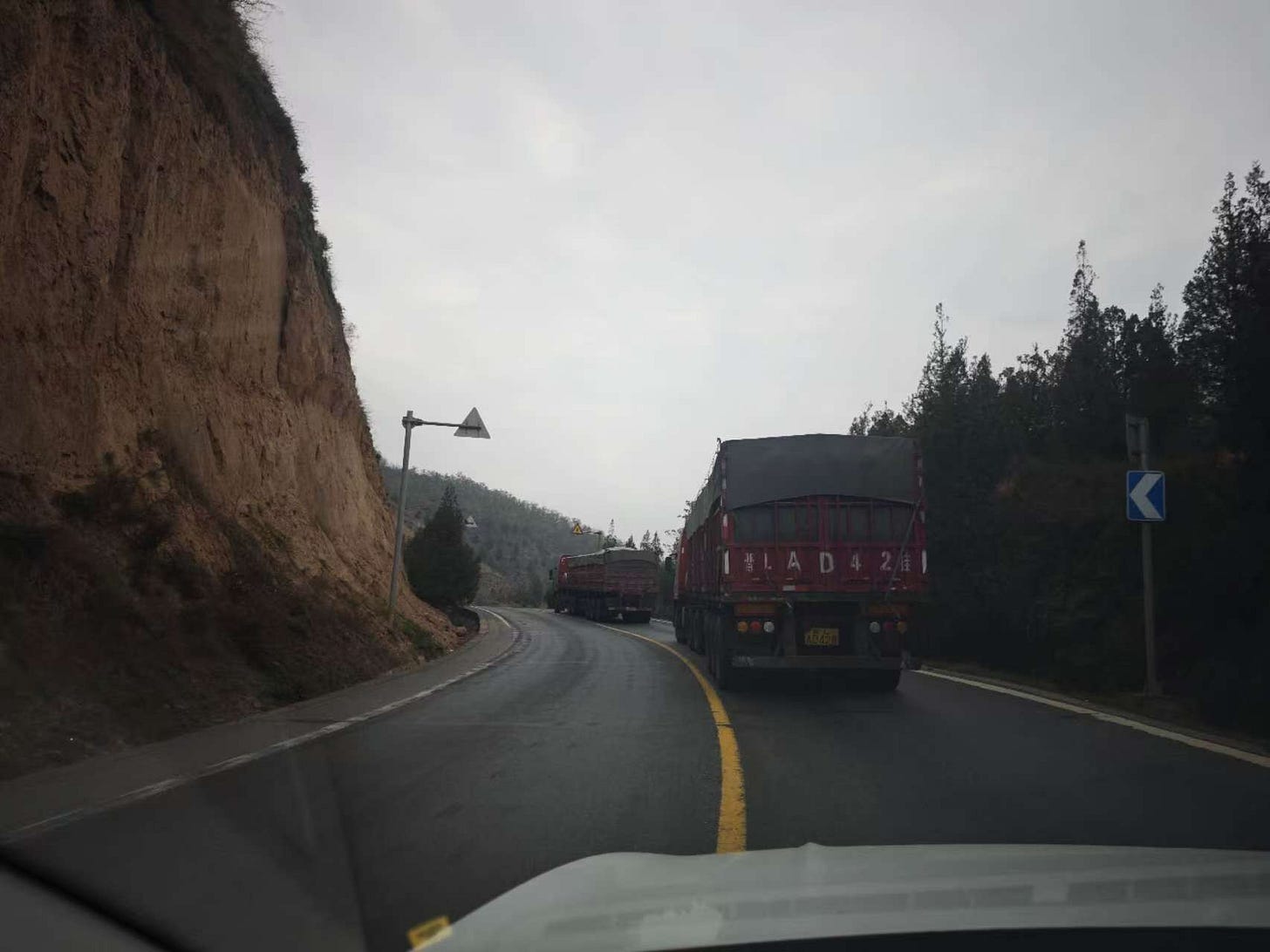
Along the way, I found something quite unexpected sprouting out of the cliff faces alongside the road: cave homes. I knew cave homes were still a thing in the loess plateau regions of Shaanxi and Gansu, and in retrospect it made sense that I’d find them here too, but I still wasn’t expecting for my day trip to morph into a cultural site visit as well.
The pathway up to this cluster of three caves was overgrown and they had obviously been abandoned for many years. I noted they previously had electricity, and while the accomodations were humble, they seemed basically similar to any other small home in these rural areas - except of course that they were caves built into a cliff face. The door to one house was open, and the style of decorations suggested the house had probably been abandoned for 20+ years.
There were a few scraps and bits lying around the house still, and I saw a traditional wood-burning stove often used in rural kitchens (not sure where the smoke goes). Interesingly, the original inhabitants had apparently been Christians - at least assuming from the pictures of Jesus on the wall flanking the faded wedding photos of the cave’s previous occupants. As recently as 2010, an estimated 30 million people still lived in traditional cave dwellings like these across north-central China. Unfortunately, more recent statistics eluded me.3
Continuing towards the Ji County seat, the chunks of coal alongside the road gradually disappeared, replaced by something else clearly falling from trucks instead: apples. Ji County is famous for its apple production, with up to 80% of its arable land dedicated to orchards. Although Shaanxi (not Shanxi) is the largest producer of apples in China, Ji County is directly on the border with Shaanxi and enjoys a very similar soil composition and climate. This, combined with its relatively small population, (fewer than 90k people) means it has one of the highest apple production rates per capita in the country.4
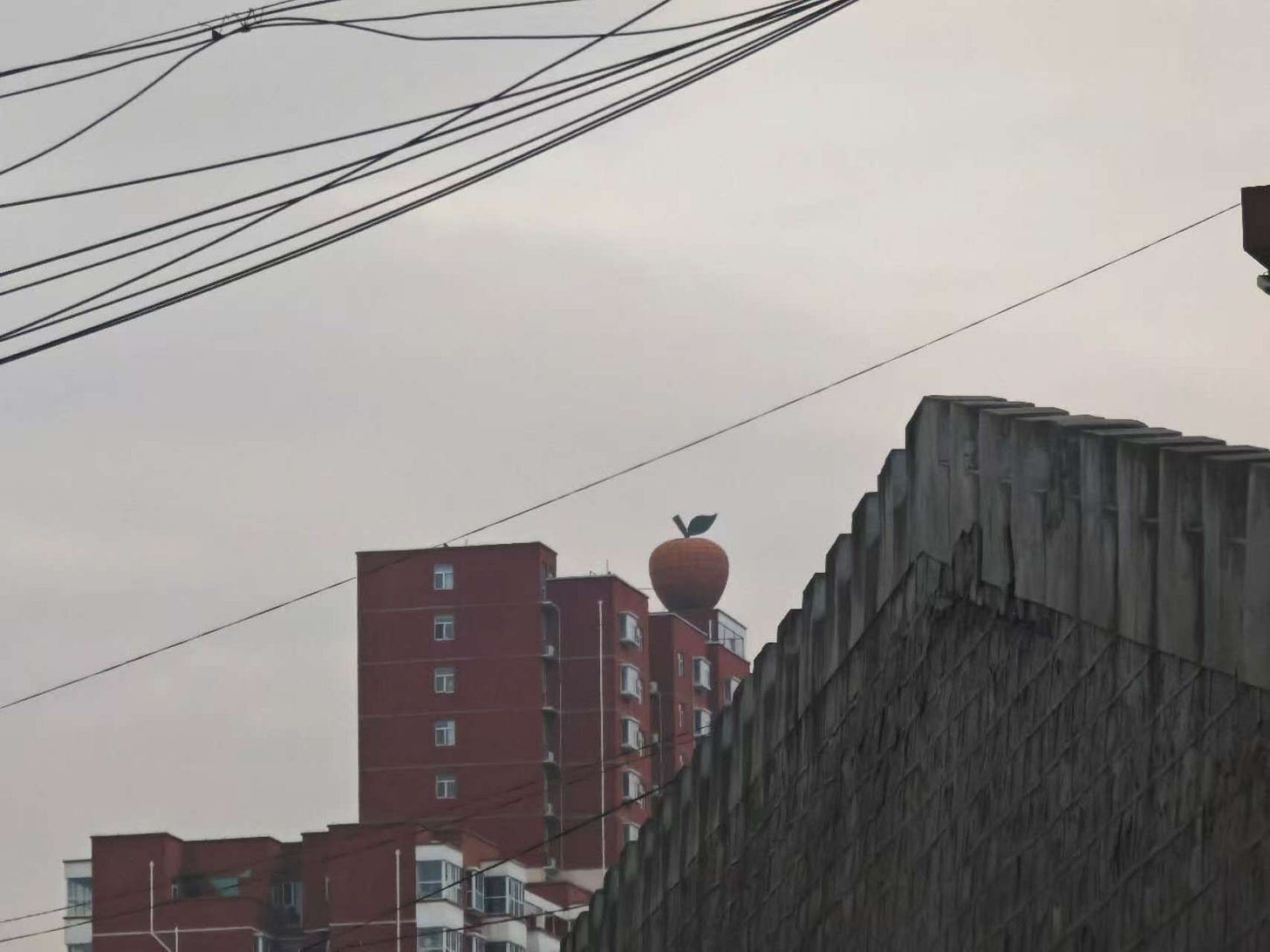
The end of the apple harvest season had arrived by the time I visited, and so it seemed just about every other building on the outskirts of town had converted into a temporary receiving area for bruised apples. I stopped the car by one massive pile of apples to survey the mound, identifying several unique cultivars. Up close, I could see that a few apples were completely rotten, but most of them looked to be just bruised - probably windfalls. I even found a few undamaged apples and tried a bite of one. It just tasted like a regular apple - crisp and sweet.
An older woman emerged from the nearby building and suspiciously asked what I was doing, making me immediately self-conscious. She didn’t seem particularly friendly, and I suppose that was quite fair; after all, I was the foreign stranger snooping around her apple pile taking uninvited bites. In my defense, I was assuming the apples were intended for animal feed... I told her I was just a tourist passing through and tried to ask a few questions.
“Hey auntie, what will you do with all these apples? Are they to feed to pigs?”
”No, they’re for juice. Someone will come to collect them and press them.”
”Ohh. Heh. Er…I thought they were for animals. Sorry…I took a bite of one. So you buy leftover bruised apples from local farmers - the ones they can’t sell to grocery stores?”
”Yes”
”You pay by weight then?”
”Yes”
”How much do you pay for a kilogram of bruised apples?”
She peered at me with the utmost skepticism. “Why do you want to know this?”
”Just curious.”
”Curious! Hah.” She shakes her head.
”It’s not convenient to tell me?”
”No, I can’t tell you.”
“Is it a secret? She continued to shake her head.
”Okay. I won’t ask for any secret information then. Sorry, auntie!”
I returned to my car and continued onward, laughing about the awkward exchange. What’s so secretive about the purchase price of bruised apples? What if I actually had a bag of bruised apples to sell…?
Exploring the Ji County Seat
Just a short way further up the road, the Ji County seat appeared. Only slightly larger than a big town, it really only comprised a few main roads and some smaller alleys. School was getting out and the roads were clogged with children. A plaza in the town center hosted several pushcart vendors, attracting throngs of children. I parked the car on the side of the road and proceeded on foot, attracting wide-eyed stares from the kids. Not a lot of foreigners make it out here I guess. On the side of the main road, I discovered an old, seemingly abandoned village house, completely blocking the sidewalk. This is a nail house, or dingzi hu (钉子户) in Chinese - someone unable to reach an agreement with authorities on an appropriate compensation level for their home and thus remaining a holdout, resisting the tide of urban development. Fortunately for the municipal authorities, this one was was only blocking the sidewalk, not the road, so it wasn’t terribly disruptive and seems to have just been left there.5
I found a grocery store and stepped in to assess the offerings. While it was obviously smaller in scale than something I would see in Shanghai or Shenzhen, the layout, options, and design were all very similar to grocery stores in larger cities. I’d invite anyone inclined to claim modern or clean grocery stores are only a feature of large cities to visit Shenglong Supermarket of Ji County, Linfen!
I didn’t really need anything, but after wandering aimlessly around the supermarket for a few minutes, (and attracting many more stares) I decided to buy some winter dates, (冬枣) which I knew are local products. Of course they were much cheaper than they would have been in Shanghai - just 7.6 CNY per kilogram.
Back on the street, I decided to find a local fruit vendor to procure some local apples. From online research, I had seen Ji County produces many different apple cultivars, so I was looking forward to trying something other than the ubiquitous Red Fuji apple, standard across supermarkets nationwide and surprisingly popular with Chinese consumers despite its (to me) overwhelming - even cloying - sweetness. I was particular keen to try something a bit more exotic and tart, either the Xiangfei apple or Ruixue apple, which I knew were grown in Ji County6. Unfortunately, when I asked a fruit vendor if she had any Xiangfei or Ruixue for sale, she laughed in my face.
“Come on, you think we could sell those apples here in this town? Those cost 40 CNY per kilo! No one here is paying 40 CNY for a kilogram of apples. Those products are only sold in the big cities. Here, I have…Red Fuji and Striped Fuji. They’re both good, from our own orchards.”
Well. I’d come all this way. So I guess I’d better buy something. I got a kilo of Red Fujis and continued chatting with the apple vendor.
“This town is so small. I guess everyone here is local?”
”Yes, we’re all from Ji County. There are not many people from outside.”
Does everyone grow apples?”
”If they have land, then they probably grow apples. As long as it’s flat land, you can grow apples.”
”And it’s all kinds of apple products?”
”Fresh apples and juice mostly. Starting from the last month of August, we will have a different kind of apple reaching maturity each week, ready to harvest. We have 15 kinds of apples in Ji County, all ripening at different times.”
”I see. But now, all you have is Fuji?”
”Yes. They ripen later, and they also can be stored for a long time.”
”Oh. As far as I can tell, it seems Ji County is really only this one big street…”
”There’s two streets total. This street has all the stores and hotels, and that street has all the restaurants. It’s really a small place.”
”How do you feel about living in a small town like Ji County? Is it comfortable?”
”Very comfortable. It’s not like the big city, where going out is so inconvenient, with the traffic. Everything is much more affordable here compared to big cities. From here, if I drive a car for one hour, I can reach Linfen, Yuncheng, even Shaanxi or Henan. In Taiyuan, if you drive a car for one hour, you can only reach the Taiyuan suburbs!”7
She finished weighing out my apples and I paid, but I still had one more question. I pointed across the street to the nail house. “Hey do you know about the nail house? What’s the situation there? Why didn’t they agree to move?”
She rolled her eyes and clicked her tongue “啧啧. I heard they demanded 10M CNY in compensation. Who would give them so much?”
It was getting dark, so at this point I decided to wrap up my exploratory trip through Ji County and head back to Linfen city for dinner. A perfect day of exploration was concluded with a dinner featuring perhaps the most famous dish from Shanxi that isn’t a noodle: 过油肉, or quick-fried pork (lit. “passing the oil pork”). Stuffed and happy, I returned to my hotel to scribble notes and reflect on the day.
Final Thoughts
In my last essay, I concluded Linfen City overall probably wasn’t the best representative of a national median city, but could be taken as a decent proxy for the “post-industrial northern Chinese city trying to reinvent itself” archetype. Importantly, and highly educationally, that model and that observation doesn’t apply to Ji County at all. Ji County is thriving! It never had a really strong coal or steel industry, so it’s not feeling the sting of their decline. Ji County economy revolves around its signature apple industry, which is likely to see increased production as Chinese agriculture continues to modernize and mechanize. It is also very fortunate to have a powerful 5A tourist attraction to drive tourism consumption - along with some clever local festivals.
Furthermore, Ji County doesn’t appear to suffer from the inflated real estate prices afflicting downtown Linfen. I saw brand new high-rise apartments in Ji County listed for as little as 4,500 CNY/sqm, which is well within a normal range for small cities, and half the price of a new apartment in Yaodu District. Used apartments are surely even cheaper. Overall, my trip made me feel that while Linfen might suffer from an uncertain future, Ji County has a lot more too look forward to.
Footnotes:
The largest is Huanggoushu Waterfall in Anshun City, Guizhou.
Local shops had even cheaper options - less than 10 USD per day, but they needed a Chinese ID.
That number is surely much lower than 30m today, but I was unable to find an updated estimate from recent years.
Ji County brands itself as China’s “home of apples” (苹果之乡). Frankly, there are probably lots of “home of apples” in China…it’s a big country with a lot of apple-producing regions. Shanxi isn’t even in the top three provinces for apple production.
Chinese eminent domain regulations are actually far less robust in such situations than many people would assume. There are many examples of such “nail houses” holding up development, especially when the developer is a state-owned enterprise.
Xiangfei Apple is 香妃苹果, a bud mutation of the Envy (爱妃) apple from New Zealand, while Ruixue is 瑞雪苹果, a relatively new varietal from the horticulture program at Shaanxi’s Northwest Agriculture and Forestry University. Read more here.
The capital and largest city of Shanxi Province.


